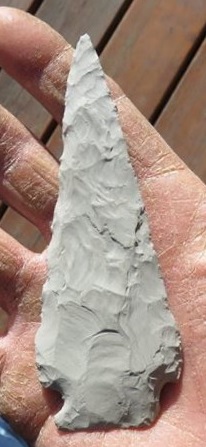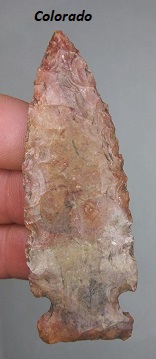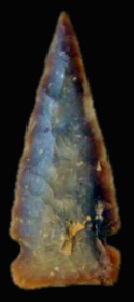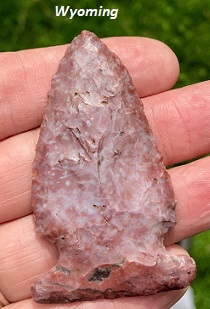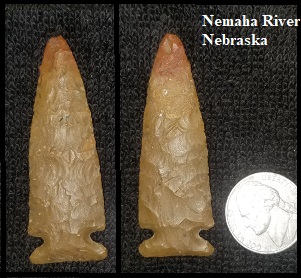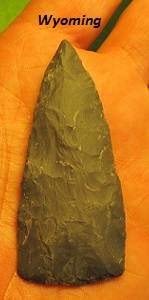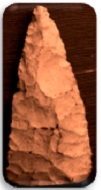Pictures Provided By:
Brittany Neemann
Jim Branger
Loyd Doty
References: (See Reference Page, Entry Number):
92
Plains Triangular Knife
Name Details:
Named By: Richard "Scotty" MacNeish
Named For: Plains
Culture
Date Identified: 1954
Type Site:
Plains Triangular Knife
Cluster:
Commonly Utilized Material:
A variety of locally available materials commonly heat
treated.
Date:
Cultural Period:
Glacial Period:
Culture:
700 - 200 B.P.
Developmental - Late Prehistoric
Medieval Warm
Outline is Representative of Common Size and Shape:

Side
Notch Form

Un-Notch
Form
Description of Physical Characteristics and Flaking Pattern:
This is a
thin medium to large (3 to 4 inches) knife with an elliptical to flattened cross section. The blade may range from straight to excurvate
or recurvate. This point has high narrow parallel notches creating shoulders that are horizontal. The stem is expanded and usually wider than the blade. The base varies from straight to concaved with basal grinding
common. This point
is manufactured using pressure flaking forming a random flaking pattern and commonly has high quality flaking.
Size Measurements - Date Needed
Distribution:
Distribution Comments:
This point is associated with nomadic bison hunters of the plains and prairie region. This point is found from the plains of Saskatchewan and Alberta into the Plains of
Montana, North and South Dakota. May be found into the plains region of Colorado, Nebraska and into Kansas.
The highest concentrations of these points are found in the southern
region of the plains suggesting a Mississippian cultural influence (Drager
and Ireland (1986)

Additional Comments:
Loyd Doty writes:
"PLAINS
KNIFE (Side Notch) – was defined by R.S. MacNeish, R. Forbis, and T. Kehoe. They are large (3” to 4”), hafted knives and variations of the Plains Side Notch
projectile. Type description is much
the same but that they are considerably larger (3” to 4”) than PSN’s, having
straight or concave bases that are ground, and they often exhibit recurved
blades as a result of repeated sharpening. Distribution includes (2nd map below) Canada, the northern
tier of Plains States south to northeast Colorado and northwest Kansas and
they were in use during the Late Prehistoric period. Reference: Kehoe, Thomas 1966:833, The Small Side-notched Point System of the Northern Plains. American
Antiquity 31(6): 827-841. "
Other points in this Cluster:
Point Validity: Valid Type
MacNeish was a pioneering anthropologist who was most notable for his excavations and studies at Tamaulipas Mexico. This type has been references in professional
publications and is considered a valid type.
Age Details:
 Un-Notch
Form
Un-Notch
Form
